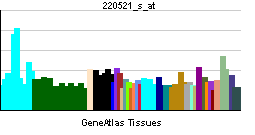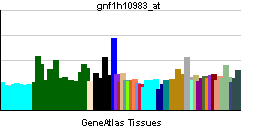ATG16L1
| ATG16 autophagy related 16-like 1 (S. cerevisiae) | |||||||||||
|---|---|---|---|---|---|---|---|---|---|---|---|
| Identifiers | |||||||||||
| Symbols | ATG16L1 ; APG16L; ATG16L; FLJ00045; FLJ10035; FLJ10828; FLJ22677; WDR30 | ||||||||||
| External IDs | Template:OMIM5 Template:MGI HomoloGene: 41786 | ||||||||||
| |||||||||||
| RNA expression pattern | |||||||||||
 | |||||||||||
 | |||||||||||
 | |||||||||||
| More reference expression data | |||||||||||
| Orthologs | |||||||||||
| Template:GNF Ortholog box | |||||||||||
| Species | Human | Mouse | |||||||||
| Entrez | n/a | n/a | |||||||||
| Ensembl | n/a | n/a | |||||||||
| UniProt | n/a | n/a | |||||||||
| RefSeq (mRNA) | n/a | n/a | |||||||||
| RefSeq (protein) | n/a | n/a | |||||||||
| Location (UCSC) | n/a | n/a | |||||||||
| PubMed search | n/a | n/a | |||||||||
ATG16 autophagy related 16-like 1 (S. cerevisiae), also known as ATG16L1, is a human gene.[1]
References
Further reading
- Venter JC, Adams MD, Myers EW; et al. (2001). "The sequence of the human genome". Science. 291 (5507): 1304–51. doi:10.1126/science.1058040. PMID 11181995.
- Strausberg RL, Feingold EA, Grouse LH; et al. (2003). "Generation and initial analysis of more than 15,000 full-length human and mouse cDNA sequences". Proc. Natl. Acad. Sci. U.S.A. 99 (26): 16899–903. doi:10.1073/pnas.242603899. PMID 12477932.
- Mizushima N, Kuma A, Kobayashi Y; et al. (2004). "Mouse Apg16L, a novel WD-repeat protein, targets to the autophagic isolation membrane with the Apg12-Apg5 conjugate". J. Cell. Sci. 116 (Pt 9): 1679–88. PMID 12665549.
- Clark HF, Gurney AL, Abaya E; et al. (2003). "The secreted protein discovery initiative (SPDI), a large-scale effort to identify novel human secreted and transmembrane proteins: a bioinformatics assessment". Genome Res. 13 (10): 2265–70. doi:10.1101/gr.1293003. PMID 12975309.
- Ota T, Suzuki Y, Nishikawa T; et al. (2004). "Complete sequencing and characterization of 21,243 full-length human cDNAs". Nat. Genet. 36 (1): 40–5. doi:10.1038/ng1285. PMID 14702039.
- Bouwmeester T, Bauch A, Ruffner H; et al. (2004). "A physical and functional map of the human TNF-alpha/NF-kappa B signal transduction pathway". Nat. Cell Biol. 6 (2): 97–105. doi:10.1038/ncb1086. PMID 14743216.
- Gerhard DS, Wagner L, Feingold EA; et al. (2004). "The status, quality, and expansion of the NIH full-length cDNA project: the Mammalian Gene Collection (MGC)". Genome Res. 14 (10B): 2121–7. doi:10.1101/gr.2596504. PMID 15489334.
- Zheng H, Ji C, Li J; et al. (2005). "Cloning and analysis of human Apg16L". DNA Seq. 15 (4): 303–5. PMID 15620219.
- Kimura K, Wakamatsu A, Suzuki Y; et al. (2006). "Diversification of transcriptional modulation: large-scale identification and characterization of putative alternative promoters of human genes". Genome Res. 16 (1): 55–65. doi:10.1101/gr.4039406. PMID 16344560.
- Hampe J, Franke A, Rosenstiel P; et al. (2007). "A genome-wide association scan of nonsynonymous SNPs identifies a susceptibility variant for Crohn disease in ATG16L1". Nat. Genet. 39 (2): 207–11. doi:10.1038/ng1954. PMID 17200669.
- Ewing RM, Chu P, Elisma F; et al. (2007). "Large-scale mapping of human protein-protein interactions by mass spectrometry". Mol. Syst. Biol. 3: 89. doi:10.1038/msb4100134. PMID 17353931.
- Prescott NJ, Fisher SA, Franke A; et al. (2007). "A nonsynonymous SNP in ATG16L1 predisposes to ileal Crohn's disease and is independent of CARD15 and IBD5". Gastroenterology. 132 (5): 1665–71. doi:10.1053/j.gastro.2007.03.034. PMID 17484864.
- Yamazaki K, Onouchi Y, Takazoe M; et al. (2007). "Association analysis of genetic variants in IL23R, ATG16L1 and 5p13.1 loci with Crohn's disease in Japanese patients". J. Hum. Genet. 52 (7): 575–83. doi:10.1007/s10038-007-0156-z. PMID 17534574.
- Baldassano RN, Bradfield JP, Monos DS; et al. (2007). "Association of the T300A non-synonymous variant of the ATG16L1 gene with susceptibility to paediatric Crohn's disease". Gut. 56 (8): 1171–3. doi:10.1136/gut.2007.122747. PMID 17625155.
| This protein-related article is a stub. You can help Wikipedia by expanding it. |